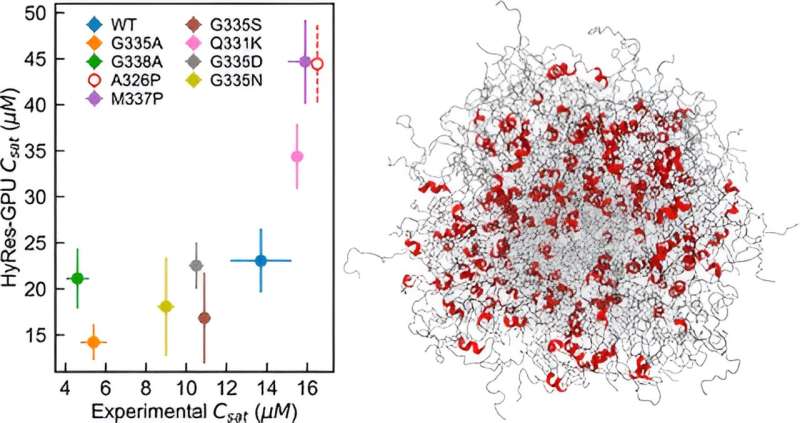This article has been reviewed according to Science X's editorial process and policies. Editors have highlighted the following attributes while ensuring the content's credibility:
fact-checked
peer-reviewed publication
trusted source
proofread
New simulation tool advances molecular modeling of biomolecular condensates

A University of Massachusetts Amherst team has made a major advance toward modeling and understanding how intrinsically disordered proteins (IDPs) undergo spontaneous phase separation, an important mechanism of subcellular organization that underlies numerous biological functions and human diseases.
IDPs play crucial roles in cancer, neurodegenerative disorders and infectious diseases. They make up about one-third of proteins that human bodies produce, and two-thirds of cancer-associated proteins contain large, disordered segments or domains. Identifying the hidden features crucial to the functioning and self-assembly of IDPs will help researchers understand what goes awry with these features when diseases occur.
In a paper published in the Journal of the American Chemical Society, senior author Jianhan Chen, professor of chemistry, describes a novel way to simulate phase separations mediated by IDPs, an important process that has been difficult to study and describe.
"Phase separation is a really well-known phenomenon in polymer physics, but what people did not know until about 15 years ago was that this is also a really common phenomenon in biology," Chen explains. "You can look at phase separation with a microscope, but to understand this phenomenon at the molecular level is very difficult.
"In the past five or 10 years, people have started to discover that many of these disordered proteins can drive phase separation, including numerous important ones involved in cancer and neurodegenerative disorders."
The new paper, based on research in Chen's computational biophysics and biomaterials lab, constitutes one chapter of lead author Yumeng Zhang's Ph.D. dissertation. Zhang will start work as a postdoctoral researcher at Massachusetts Institute of Technology (MIT) in February. Another key contributor is Shanlong Li, a postdoctoral research associate in Chen's lab.
Chen's lab developed an accurate, GPU-accelerated hybrid resolution (HyRes) force field for simulating phase separations mediated by IDPs. This model is unique in its ability to accurately describe peptide backbone interactions and transient secondary structures, while being computationally efficient enough to model liquid-liquid phase separation. This new model fills a critical gap in the existing capability in computer simulation of IDP phase separation.
Chen and team created HyRes simulations to demonstrate for the first time what governs the condensate stability of two important IDPs.
"I actually did not anticipate that it could do such a good job at describing phase separation because it's a really difficult phenomenon to simulate," Chen says. "We demonstrated that this model is accurate enough to start looking at the impacts of even a single mutation or residual structures in the phase separation."
The researchers' HyRes-GPU provides an innovative simulation tool for studying the molecular mechanisms of phase separation. The ultimate goal is to develop therapeutic strategies in the treatment of diseases associated with disordered proteins.
"This is really the significance of this work," Chen says. "Important biological processes are believed to occur through phase separation. So, if we can understand better what controls this process, that knowledge will be really powerful, if not essential, for us to think about controlling phase separation for various scientific and engineering purposes. This will help us understand the type of intervention that will be required to achieve therapeutic effects."
Chen says the next step is to apply what his team has learned to larger-scale simulations of more complex biomolecular mixtures.
"Shanlong is now working on constructing a similar model for nucleic acids because phase separation often involves both disordered proteins and nucleic acids," he says. "We want to be able to describe both key components, and that would allow us to look at many more systems."
More information: Yumeng Zhang et al, Toward Accurate Simulation of Coupling between Protein Secondary Structure and Phase Separation, Journal of the American Chemical Society (2023). DOI: 10.1021/jacs.3c09195
Journal information: Journal of the American Chemical Society
Provided by University of Massachusetts Amherst





















